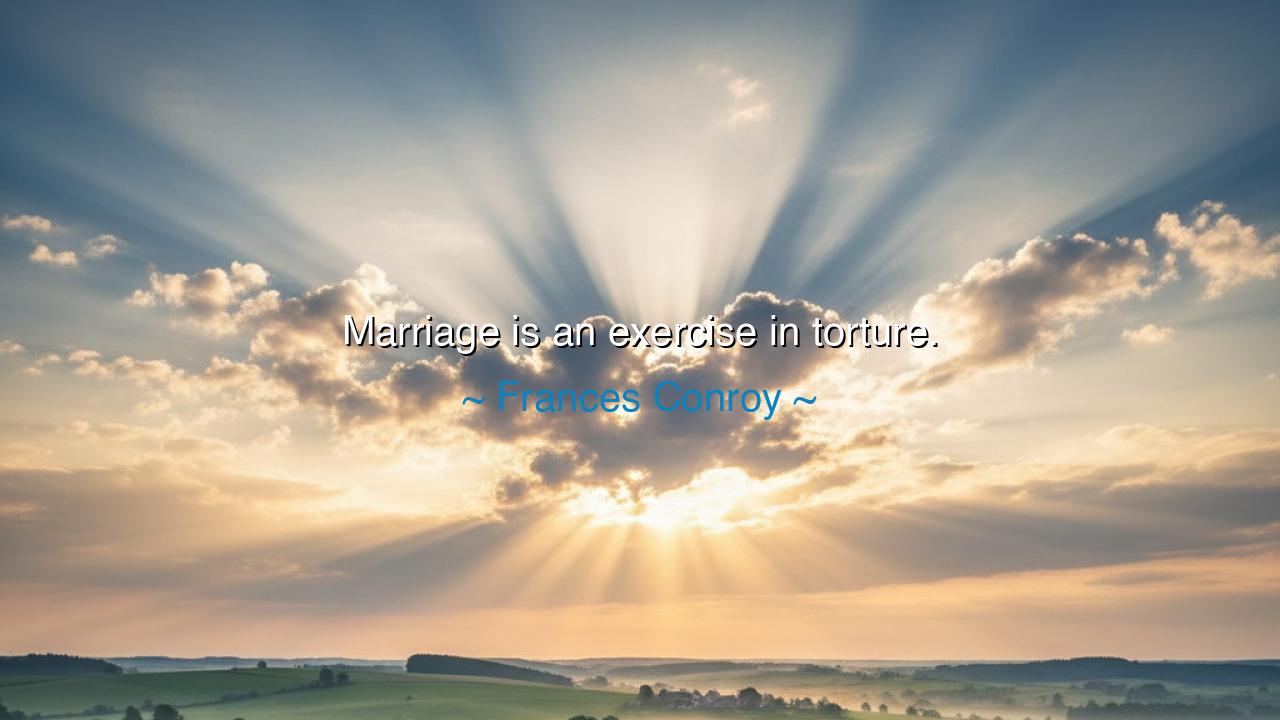
Marriage is an exercise in torture.






“Marriage is an exercise in torture,” declared Frances Conroy, and though her words sound harsh, they carry a truth forged in the fire of human experience. For marriage, though often cloaked in the garments of joy and companionship, also binds two imperfect beings together in the crucible of daily life. It is not the torture of cruelty or malice, but the slow and unrelenting test of endurance, patience, and sacrifice. Just as iron is tempered only through flame, so too is the bond of marriage tested through hardship, friction, and the unyielding grind of years.
The ancients spoke of love as both a blessing and a trial. The Greeks told the tale of Orpheus and Eurydice, whose union was shattered by loss, testing Orpheus’ devotion even into the underworld. This myth reveals the same essence that Conroy’s words touch upon: that marriage is not simply sweetness, but a path where love must continually struggle against disappointment, sorrow, and the shadows of mortality. To live bound to another is to carry their burdens as your own, and in this bearing, one’s strength and weaknesses are laid bare.
Indeed, many who have walked this path can testify. Consider the long union of John and Abigail Adams, figures from America’s founding. Their marriage endured separation for years at a time, while John labored in the service of the young republic abroad. Letters passed between them, filled with longing, counsel, and occasional rebuke. Their love was deep, but not without strain. Yet it was precisely this torture of distance, sacrifice, and duty that forged their relationship into something enduring, something capable of weathering the storms of history.
When Conroy names marriage as torture, she calls our attention not to despair, but to the struggle that refines. The daily clashes over pride, the wounds of unkind words, the trials of unmet expectations—these grind upon the spirit. And yet, if endured with humility and care, they carve out a deeper intimacy, just as relentless waters carve valleys into stone. The torture lies in the relentless exposure of the self, where one cannot hide behind masks, for a spouse comes to know not only the face of the beloved, but also the shadows that dwell within.
This is no small thing, for many flee from such trials. Some falter, some break, some seek escape. But others endure, and in enduring, discover a depth of love that is not mere infatuation or fleeting passion, but something forged, scarred, and resilient. It is like the soldier who marches through agony to victory; the pain is real, but the triumph is also real. Marriage in this light is both torment and transcendence, a crucible that burns away illusions until only truth remains.
What then is the lesson for us, the listeners of this ancient truth? It is to enter marriage not with illusions of endless bliss, but with courage to face the trials it brings. Do not shrink from the discomfort, for within it lies growth. Do not flee from the torture, but let it shape you into one who knows patience, forgiveness, and strength. To love is to suffer, but also to be transformed.
Practical wisdom follows from this: speak with honesty, even when it wounds. Practice forgiveness, for without it the chain will break under strain. Remember that endurance itself is a form of love, and that true companionship is not built in moments of ease, but in the long years of struggle. Thus, when Conroy says marriage is an exercise in torture, let us not recoil, but understand: it is a holy suffering, a training of the soul, and if endured with grace, it leads not to despair but to a love profound, steadfast, and eternal.






AAdministratorAdministrator
Welcome, honored guests. Please leave a comment, we will respond soon